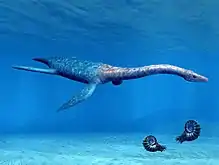Attenborosaurus
Attenborosaurus is an extinct genus of pliosaurid from the Early Jurassic of Dorset, England. The type species is A. conybeari. The genus is named after David Attenborough,[1] the species after William Conybeare.[2]
| Attenborosaurus Temporal range: Early Jurassic, | |
|---|---|
 | |
| Casts of the holotype specimen (NHMUK R1339): one showing the left side view of the thorax (top) and another showing the underside of the body and right side view of the neck and skull (bottom), Natural History Museum | |
| Scientific classification | |
| Domain: | Eukaryota |
| Kingdom: | Animalia |
| Phylum: | Chordata |
| Class: | Reptilia |
| Superorder: | †Sauropterygia |
| Order: | †Plesiosauria |
| Family: | †Pliosauridae |
| Genus: | †Attenborosaurus Bakker, 1993 |
| Species: | †A. conybeari |
| Binomial name | |
| †Attenborosaurus conybeari Bakker, 1993 | |
| Synonyms | |
| |
History

The original remains of the holotype, specimen PV OR 38525, were discovered in Charmouth, Dorset, England in 1880[3] and was described in 1881[2] before being housed at the Bristol City Museum and Art Gallery, where a cast was taken of NHMUK R1339 and sent to the Natural History Museum in London by William Johnson Sollas, c. 1881,[2] where it stayed until the holotype was destroyed in November 1940, during World War II, leaving only plaster casts of the remains to be studied; the type cast (specimen NHMUK R1339) is now housed at the Natural History Museum, London along with a referred specimen (specimen NHMUK OR40140/R1360; includes no head, neck or tail, most of the body, ribs and all flippers except for the front right) and another partial specimen, including a skull and postcrania purchased by E.C. Day in 1866 (specimen NHMUK OR40140), also from Dorset.[3] At first the animal was thought to be another Plesiosaurus species by William Johnson Sollas in 1881,[2] but after studies on the plaster casts made after the remains, Plesiosaurus conybeari was assigned to a new genus (Attenborosaurus) by Robert T. Bakker in 1993.[1]
Description

Judging by the holotype, which is the partial remains of one single specimen, the length of the animal was about 4.3 m (14 ft).[2] Much like its plesiosaur cousins, it was piscivorous. From the skin impression found with the bones, which was later destroyed, it is presumed that the creature had membranous skin, devoid of any significantly large scales, probably for decreasing water resistances.[1]